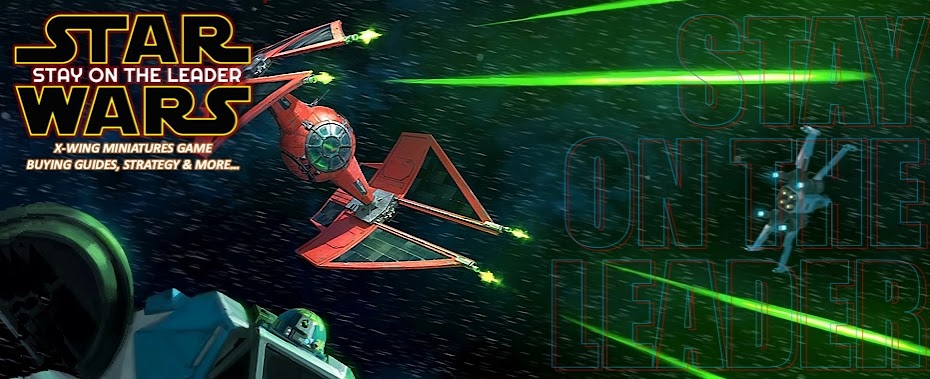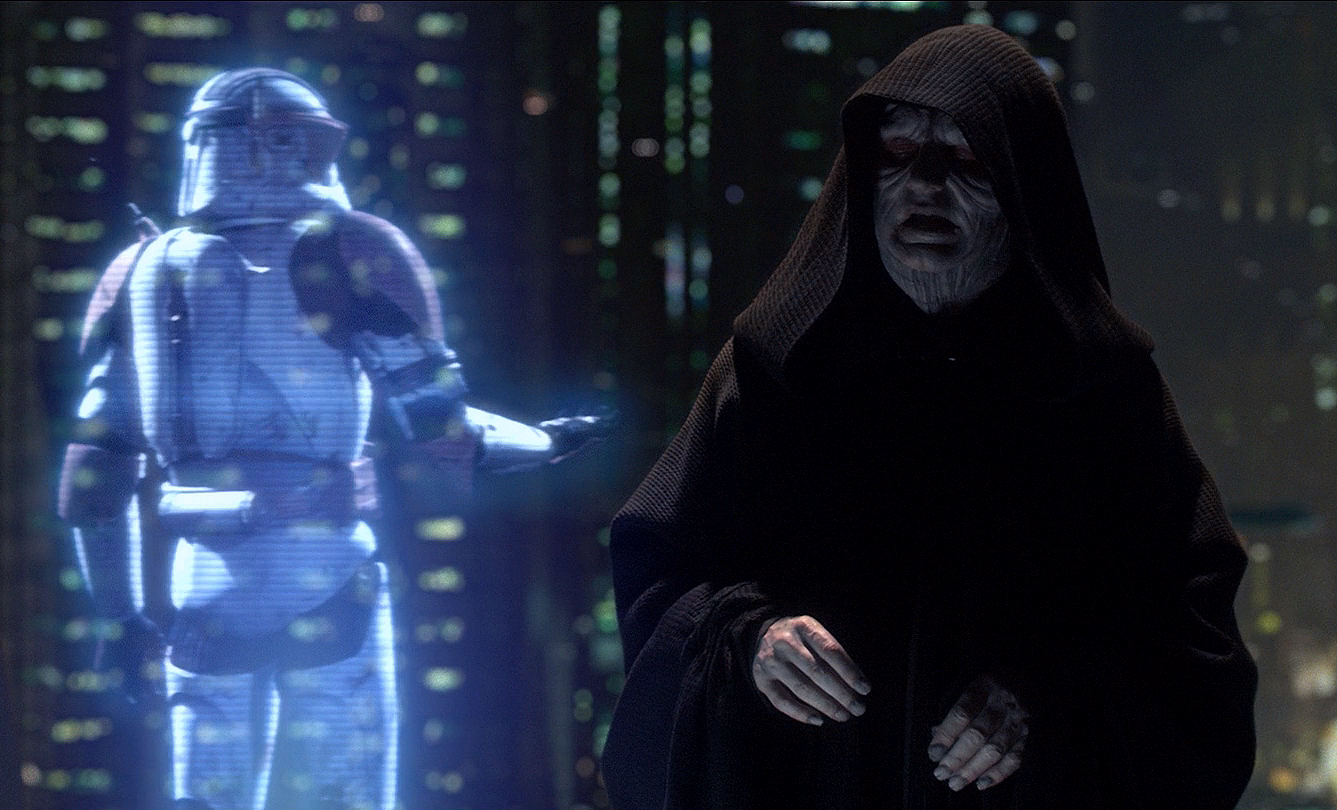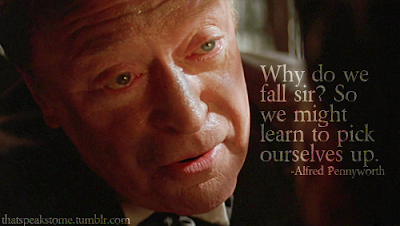Welcome to the second part of my whistlestop tour through the development of the X-Wing metagame, what I have dubbed the Six Ages of X-Wing...
It's August 2015. The X-Wing players are having a wonderful party with their metagame: turrets like Han, Oicunn and Dash, aces like Corran, Jake and Soontir, and generic jousters like Blue Squadron Pilot, Tala Squadron Pilot and Obsidian Squadron Pilot swirling around each other in an intricate dance of one-upsmanship. It's a cosy and familiar party because everyone knows their place, everyone knows how they fit together.
- Jurassic Park
- Twin Laser Palps
- Scouts
- Veterans
- Mindlink
- Rebel Revenge
Let's set the scene...
This is how the game is. It's how it's been for a long time.
Then, released two weeks apart during August, the Imperial Raider and Wave 7 crashed the party and X-Wing would never be the same again...
TWIN LASER PALPS
Of all the six 'ages' of X-Wing I'm going to talk about in this series of blogs I think this second age is probably the most important for understanding how we came to play X-Wing the way that we do now. The period between Wave 7 and Wave 8 saw the old structures of the X-Wing metagame demolished entirely and replaced with something much more recognisable as what we see today. Here are the top 20 pilots in Meta-Wing each month over this period...
Revolutions are rarely bloodless affairs. There was chaos at first as the old order struggled to survive and fight off the Wave 7 insurgency, but from the ashes of the old world a new metagame was born and by February 2016 the transition was complete.
August 2015
- Large Based Turrets
- Autothruster Aces
- Generic Jousters
February 2016
- Palp Aces
- TLT
- Rebel Regen
- Crack Swarm
EXECUTE ORDER 66
The Imperial Raider expansion thrust the two endgame bosses of Star Wars right into the metagame mix, with Darth Vader getting a much-needed buff to his ailing TIE Advanced and Emperor Palpatine finally arriving in the game.
Although Palpatine carried a hefty price tag (8pts, plus the shuttle he can ride in) players immediately seized on just how powerful his ability was and he soon ascended to his throne room at the top end of the metagame. As Palpatine was an upgrade card not a pilot you have to track his progress indirectly through the Top 20 pilots, primarily through the rapid rise of the Omicron Group Pilot that was the cheapest Lambda Shuttle carrier for the Emperor but he also quickly found himself replacing the existing crew on board the Decimator.
Palpatine's impact on the Jurassic Park metagame was huge, primarily because he added an extra layer of impenetrable defence to the green dice of the Imperial Aces that had already been hanging around near the top of the game, like Soontir Fel, Whisper, or Darth Vader in his new and improved TIE Advanced.
Until this point players knew what they needed to do to batter Imperial aces down - if you fired into all their green dice and tokens you'd struggle to scratch the paint, but if you could hit them multiple times in a turn they'd run out of tokens and your later shots would squeeze through. That was the theory behind the likes of B-Wing & TIE swarms trying to catch Soontir in multiple arcs, and it was also the theory behind the likes of Gunner or Luke Skywalker in the large-based turrets trying to push for a second shot that would do the damage.
Palpatine's extra layer of dice-meddling changed all that. Two shots weren't enough now, you'd likely need three or four, and Palp was also on duty if you managed to successfully bump your target ace as well. The Emperor's ability to bend the Force to his dark ends transcended such trivialities, and as such he was a dagger to the heart of the existing metagame.
The Jurassic Park era had seen Imperial aces used primarily alongside the Decimator a 'mini-swarm' of TIE Fighters. By being able to flexibly support wherever the point of pressure was Palpatine changed the game, making it possible for Imperial players to bring two otherwise flimsy aces and trust the Emperor to help whichever was the enemy's target. Palp Aces was born and it's a squad archetype that we can recognise as surviving largely unchanged to this day - the particular aces may switch in and out as the metagame demands, but the premise and strategy remains as valid now as it ever did.
Further still, the huge success of the Omicron Group Pilot really proved for the first time the viability of a dedicated support ship, particularly one able to influence the game from any range. That's a theme which runs strongly through many of the most dominant squads of the next few years of metagame rotation, such as Manaroo.
The only thing going wrong for his Palpness at this point, was that he was about to be upstaged...
INTENSIFY FORWARD FIREPOWER!
It's not really possible to understate the impact that Twin Laser Turret had on competitive X-Wing.
The fat turrets that had ruled over the Jurassic Park metagame couldn't compete with the raw firepower of all those turrets heading back at them - in the three turns it would take Han Solo to kill a single Y-Wing he would almost certainly die to the 72 red dice that were coming back his way. The aces could hide behind tokens and Autothrusters against the incoming fire, but the raw number of shots they had to take meant their green dice were likely to fail eventually. The B-Wings and Z-95s simply weren't fast enough to catch up to the Y-Wings and just melted under the fire.
From the second Wave 7 arrived the Syndicate Thug took over at the top of the metagame, with Quad TLT cutting a bloody swathe through almost anything else in the game. Players running their BBBBZ and Flying Pancakes into the Quad TLTs were just replicating the futility of charges across a muddy battlefield into the face of machine gun fire.
For three straight months the Syndicate Thug was the #1 pilot in Meta-Wing.
The Thug wasn't alone, though, and pretty much anything you could strap a TLT to became a solid body to put into the fray - even HWKs started to pick up wins! Alongside the Y-Wings the new K-Wings were rapidly proving a potent force - you couldn't afford four of them like you could with the smaller Y-Wing, but you could bring three K-Wings with a few more toys. Miranda Doni's powerful shield regeneration ability made her an instant success and a deadly late game finisher, while in the old timing rules TLT and Tactician combined to deal two stress tokens (one for each TLT 'attack').
The TLT/double-stress combination didn't stop there, though, and in fact it rolled on into the next turn of the metagame wheel. The 'Stresshog' Y-Wing became one of the strongest counters to disrupting the action economy of the new Palp Ace squads. With Emperor Palpatine adding to the defensive tokens of Soontir Fel, Darth Vader and Whisper it was all but pointless even trying to throw your red dice at the Imperial Aces. But deny them actions with two stress tokens, that a green maneuver won't clear it all, and they became flimsy pinatas to squish at your leisure.
The Stresshog was a key part of a brand new Rebel archetype, one that we recognise very well today: Rebel Regen.
The Rebel faction had always had access to shield regeneration - R2-D2 was in the base set and Corran Horn had been putting Artoo to good use all through the Jurassic Park age of X-Wing. But here, for the first time, was a squad where multiple ships with shield regeneration that formed a dedicated attempt to simply outlast the opponent over a long game. That's a style of play that we recognise very well today - a clear ancestor to the likes of Fair Ship Rebels, Plot Armour, or Stressbunker.
Specific pilots and upgrades may have changed, but I think this squad is very recognisable as a 'modern' X-Wing squad. It's also entirely unlike what was being played before TLT arrived in the game.
GANG WARFARE
GANG WARFARE
This all spelled the end of the line for the old generic jousting model of squad - the B-Wings, Z-95s and Osidian Squadron TIEs. Are you up against Palp Aces? You can't hit them. Are you up against Quad TLT? You can't catch them. Are you up against Rebel Regen? You lose an attrition race.
Jurassic Park had seen many various builds of jousters - B-Wings, Z-95s, TIE Fighters, BTL Y-Wings - and during this period they virtually all went extinct. All but one, which was able to change and adapt to find a new niche, in the process inventing another X-Wing squad archetype that we recognise very well today: the Alpha Strike.
Jurassic Park had seen many various builds of jousters - B-Wings, Z-95s, TIE Fighters, BTL Y-Wings - and during this period they virtually all went extinct. All but one, which was able to change and adapt to find a new niche, in the process inventing another X-Wing squad archetype that we recognise very well today: the Alpha Strike.
Crack Swarm may superficially look like the TIE Swarms that had previously existed but although it retained most of the strengths of old TIE Swarms it was able to embrace something new and become a much more potent early game threat: the Crack Swarm had Crack Shot.
The alpha-strike may have really grabbed people's attention with Deadeye Scouts, but in truth the ability to cost-effectively alpha strike arrived a wave earlier than people commonly think.
And Crack Swarm answered all the problems that generic jousters faced. Are you up against Palp Aces? Crack Shot will push damage through their defences. Are you up against Quad TLT? Your TIEs are fast enough to catch them, and with Crack Shot you'll reduce incoming fire a lot faster. Are you up against Rebel Regen? Crack Shot will give you an early spike in damage that will overwhelm their ability to regenerate shields quickly enough.
It had to be the TIE Fighters. They were fast, they were cheap enough to run as many as SIX copies of Crack Shot, with three green dice they had the best chance against TLT and with Howlrunner along for the ride they had the best chance to reliably deliver a decisive first strike. The TIEs were the last swarm left standing because in Crack Swarm they invented the alpha strike - the dedicated attempt to win the game with one decisive blow at the start of the game. That's also very recognisable as a modern X-Wing squad.
As you may have gathered so far, Wave 7 was a hammer blow that transformed the X-Wing metagame. There were a couple of archetypes that survived relatively unscathed though. The IG-88 'Brobots' had already demonstrated their ability to magpie the best pieces from the metagame around them, and during this time they were able to continue to evolve and prosper. They had the speed and green dice of the TIE Fighters and Aces against the TLTs, they had the Crack Shots and Gunner abilities against the Aces, they had the punching power of Heavy Laser Cannons to burn down the regenerating Rebels. Brobots could adapt, Brobots could survive.
Also clinging to life was Dash Rendar, probably the last of the large base turrets really standing other than the new Palpatine-laden Decimators. The heady days of the YT-2400 chassis being able to support multiple pilots in the Top-20 were long gone but Dash's long range playstyle and firepower meant he was better suited than some of the competing turrets for survival in the post-TLT landscape.
Dash's model was pretty much unchanged, and in truth the rise of Miranda Doni as a competing Rebel turret in the second half of this period meant Dash was running on fumes by the time Wave 8 arrived, but he only had to make it to the finish line in one piece and wait for Kanan Jarrus to jump aboard for a second lease of life.
Dash's model was pretty much unchanged, and in truth the rise of Miranda Doni as a competing Rebel turret in the second half of this period meant Dash was running on fumes by the time Wave 8 arrived, but he only had to make it to the finish line in one piece and wait for Kanan Jarrus to jump aboard for a second lease of life.
SUMMARY
Its February 2016 and X-Wing is a different game now.
This second age in my breakdown of X-Wing metagame history is a pivotal one in the development of the game we now play, and like any point of pivot there's a before and there's an after. The first three months, with Syndicate Thugs and Imperial Aces pinned to the top of the metagame, were about breaking down what had gone before and proving the point that it simply wasn't going to work any more. The second period, particularly through the run of Store Championships in January and February, saw players adapting to the new game and developing new strategies.
You see the two halves of this period played out in that Top-20 pilots table, with large turrets and jousters dropping away, before Miranda, Poe, Omega Leader and Black Squadron TIEs start their rise in the second half.
It's this second period in particular where we see the foundations laid for the types of squad we're still playing today: super-tanky Rebels, super-defensive Palp Aces, Twin Laser Turret spam, super-aggressive Crack Swarms.
Somewhere during this era the game had shifted gears. It was now clear that squads needed a plan and they needed to commit to it fully. Bringing 100pts of ships and trying to work it out on the table was no longer going to be good enough because players who had spent time planning their squads carefully before they got to the table were now able to build an unassailable advantage. That advantage could come from overwhelming offense (alpha strikes and TLT spam) or overwhelming defense (regen and Palpatine), but there would usually be an attempt to dedicate at least a significant portion of your squad to doing one or the other as well as you possibly could.
That's not to say that nothing now changes in X-Wing from here on forwards. I've got four more ages to cover yet and there's some pretty big missing pieces that are yet to arrive, such as buffs for ordnance -Torpedoes, Bombs and Missiles - for instance. But I would argue that in most instances those changes happen within the overarching structure of 'modern X-Wing' and the types of archetypes laid down during these pivotal few months. Overwhelming offense, overwhelming defense, intense synergies and card combinations.
I think it's also important to recognise that this period was one of seismic change for X-Wing, even outside of the impact of new waves, pilots and upgrades. Star Wars: The Force Awakens was released into cinemas alongside a new Core set, and all this happened to coincide with many disenchanted players of other systems like Warhammer 40k who were hanging about looking for something new to play. The X-Wing Miniatures Game exploded in popularity between November and February (I've seen estimates that it doubled in size), picking up more casual players who just liked Star Wars as well as attracting more hardcore competitive gamers from other systems.
Regardless of whether it was design-led or community-led, though, the game that emerged from the Store Championships in February 2016 was completely different to that which had been played in the previous tournament season, and much closer to what we're still playing today.
NEXT UP: Scouts & Veterans





















